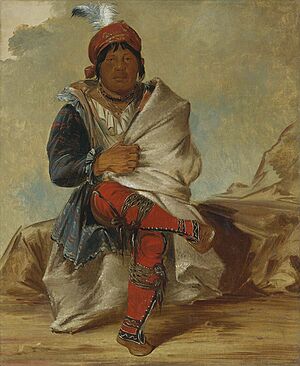Micanopy facts for kids
Micanopy (born around 1780 – died late 1848 or early 1849) was a very important leader of the Seminole people. He was their main chief during the Second Seminole War. People also knew him by names like Micco-Nuppe or Sint-chakkee, which meant "pond frequenter" before he became chief.
Contents
Micanopy's Early Life and Leadership
Micanopy's name came from the Hitchiti language. It meant "high chief." He was also called Hulbutta Hajo, or "Crazy Alligator." We don't know much about his early years. He was born near what is now St. Augustine, Florida, around 1780.
In 1819, Micanopy became the main chief of the Seminole after Chief Bolek died. The Seminole passed down leadership and property through the mother's side of the family. This is called a matrilineal system. Micanopy was nearly 40 when he became chief. He soon gained a lot of land and cattle.
Seminole Traditions and New Settlers
Micanopy hired many people to work on his lands. He also encouraged Seminole people to marry Black people. This was a long-standing Seminole tradition. They saw Black people as equals, which was different from how many white people thought at the time. Some people of mixed heritage became important leaders among the Seminole.
In 1819, the United States bought Florida from Spain. This was part of the Adams–Onís Treaty. Then, in 1821, Andrew Jackson became Florida's governor. Many American settlers began moving into northern Florida. Micanopy did not want more Americans settling there.
As more settlers arrived, conflicts grew between the Seminole and the newcomers. The Seminole were pushed away from the coast. They moved deeper into Florida's wet, swampy areas. In 1823, the Treaty of Moultrie Creek was signed. Through this treaty, Americans took 24 million acres of Seminole land in northern Florida. The Seminole then moved to central and southern parts of the territory.
Conflicts and the Second Seminole War
People who owned slaves in Florida and nearby states wanted the Seminole to return those who had escaped and found safety with them. More large cotton farms were growing in Florida. These farms needed many workers, so more slaves were bought. Some of these workers continued to escape.
Pressure on the Seminole grew. In 1830, the Indian Removal Act was passed. This law pushed for Native American tribes to be moved from their lands. A group of Seminole chiefs eventually agreed to the Treaty of Payne's Landing in 1832. On May 9, 1832, they gave up more Seminole lands. In return, they were promised a reservation in the Indian Territory (which is now Oklahoma).
Micanopy's Resistance and Battles
Micanopy tried to find a peaceful solution. However, he refused to sign the treaty. He joined younger chiefs like Osceola, Alligator, and Wild Cat (who was his nephew). They all opposed the treaty. They began to organize Seminole warriors to resist.
In December 1835, Osceola killed a U.S. Indian agent named General Wiley Thompson. Soon after, Micanopy and Osceola attacked U.S. forces. They fought against Major Francis Langhorne Dade and General Duncan Lamont Clinch. Only three soldiers survived what Americans called Dade's Massacre. Settlers demanded that the U.S. military take action against the Seminole. This is how the Second Seminole War began.
The Seminole had some early successes in the war. But Micanopy, who was getting older, began to see that fighting was hopeless. He realized how many American soldiers could be sent against the Seminole. In June 1837, he surrendered. He started to talk about moving his tribe to the Indian Territory. But then, Osceola kidnapped him.
In December 1838, Micanopy was captured again by General Thomas S. Jesup's forces. This happened while Micanopy was under a flag of truce, meaning he was there for peaceful talks. He had already agreed to sign a peace treaty. Many people thought this action by the U.S. was very wrong. It made them feel more sympathy for the Seminole.
Life in Indian Territory
Micanopy was held in prison in Charleston, South Carolina. Later, he was released. He was sent with about 200 other Seminole people to the Indian Territory. At first, they were placed under the authority of the Creek Nation. However, the Seminole people had been independent for a long time.
Micanopy tried to make the Seminole independent again. But he never got back his full power. In 1845, he signed a treaty with the U.S. This treaty gave the Seminole in western Florida some independence from the Creek Nation in Indian Territory. The treaty also said that the Seminole would get full independence in 1855. Micanopy died at Fort Gibson on January 2, 1849.
Since the Seminole had a matrilineal system, his sister's son, Jim Jumper, became the main chief after Micanopy. The Seminole slowly rebuilt their communities and traditions in Indian Territory. After Jim Jumper died four years later, his brother, John Jumper, became chief. He led the tribe until after the American Civil War.
Legacy and Honors
The town of Micanopy, Florida was named after this important chief. It was built where his main town, Cuscowilla, used to be.



